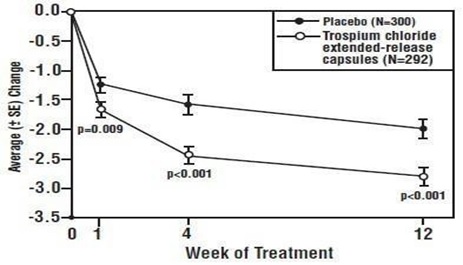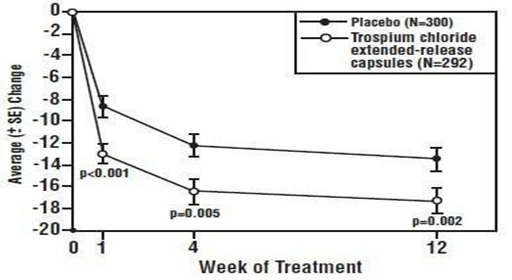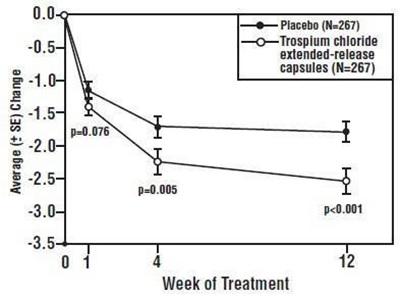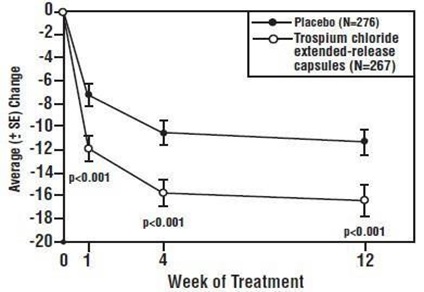TROSPIUM CHLORIDE
TROSPIUM CHLORIDE EXTENDED-RELEASE CAPSULES These highlights do not include all the information needed to use TROSPIUM CHLORIDE EXTENDED-RELEASE CAPSULES safely and effectively. See full prescribing information for TROSPIUM CHLORIDE EXTENDED-RELEASE CAPSULES. TROSPIUM CHLORIDE extended-release capsules, for oral use Initial U.S. Approval: 2004
5c088397-f407-4606-95a0-d9fe619888c3
HUMAN PRESCRIPTION DRUG LABEL
Jul 28, 2023
Granules Pharmaceuticals Inc.
DUNS: 079825711
Products 1
Detailed information about drug products covered under this FDA approval, including NDC codes, dosage forms, ingredients, and administration routes.
TROSPIUM CHLORIDE
Product Details
FDA regulatory identification and product classification information
FDA Identifiers
Product Classification
Product Specifications
INGREDIENTS (21)
Drug Labeling Information
WARNINGS AND PRECAUTIONS SECTION
5 WARNINGS AND PRECAUTIONS
5.1 Risk of Urinary Retention
Trospium Chloride Extended-Release Capsules should be administered with caution to patients with clinically significant bladder outflow obstruction because of the risk of urinary retention [ see Contraindications (4)].
5.2 Angioedema
Angioedema of the face, lips, tongue and/or larynx has been reported with trospium chloride. In one case, angioedema occurred after the first dose of trospium chloride. Angioedema associated with upper airway swelling may be life threatening. If involvement of the tongue, hypopharynx, or larynx occurs, trospium chloride should be promptly discontinued and appropriate therapy and/or measures necessary to ensure a patent airway should be promptly provided.
5.3 Decreased Gastrointestinal Motility
Trospium Chloride Extended-Release Capsules should be administered with caution to patients with gastrointestinal obstructive disorders because of the risk of gastric retention [ see Contraindications (4)]. Trospium Chloride Extended-Release Capsules, like other antimuscarinic agents, may decrease gastrointestinal motility and should be used with caution in patients with conditions such as ulcerative colitis, intestinal atony and myasthenia gravis.
5.4 Controlled Narrow-angle Glaucoma
In patients being treated for narrow-angle glaucoma,Trospium Chloride Extended-Release Capsules should only be used if the potential benefits outweigh the risks, and in that circumstance only with careful monitoring [see Contraindications (4 )].
5.5 Central Nervous System Effects
Trospium Chloride Extended-Release Capsules and Trospium Chloride Immediate Release Capsules are associated with anticholinergic central nervous system (CNS) effects [see Adverse Reactions (6.2 )]. A variety of CNS anticholinergic effects have been reported, including dizziness, confusion, hallucinations and somnolence. Patients should be monitored for signs of anticholinergic CNS effects, particularly after beginning treatment or increasing the dose. Advise patients not to drive or operate heavy machinery until they know how Trospium Chloride Extended-Release Capsules affects them. If a patient experiences anticholinergic CNS effects, dose reduction or drug discontinuation should be considered.
5.6 Patients with Severe Renal Impairment
Trospium Chloride Extended-Release Capsules are not recommended for use in patients with severe renal impairment (creatinine clearance less than 30 mL/minute) [see Dosage and Administration (2), Use in Specific Populations (8.6), and Clinical Pharmacology (12.3 )].
5.7 Alcohol Interaction
Alcohol should not be consumed within 2 hours of Trospium Chloride Extended- Release Capsules administration. In addition, patients should be informed that alcohol may enhance the drowsiness caused by anticholinergic agents.
•Trospium Chloride Extended-Release Capsules should be administered with caution to patients with clinically significant bladder outflow obstruction or gastrointestinal obstructive disorders due to risk of urinary or gastric retention. ( 5.1, 5.3)
• Angioedema of the face, lips, tongue and/or larynx has been reported with trospium chloride. ( 5.2)
• In patients with narrow angle glaucoma, Trospium Chloride Extended-Release Capsules should be used only with careful monitoring. ( 5.4)
• Central Nervous System Effects: Somnolence has been reported with Trospium Chloride Extended-Release Capsules. Advise patients not to drive or operate heavy machinery until they know how Trospium Chloride Extended-Release Capsules affects them. ( 5.5)
• Trospium Chloride Extended-Release Capsules are not recommended for use in patients with severe renal impairment (creatinine clearance less than 30 mL/minute). ( 5.6)
• Alcohol should not be consumed within 2 hours of Trospium Chloride Extended- Release Capsules administration. ( 5.7)
ADVERSE REACTIONS SECTION
6 ADVERSE REACTIONS
6.1 Clinical Trials Experience
Because clinical trials are conducted under widely varying conditions, the adverse reaction rates observed in the clinical trials of a drug cannot be directly compared to rates in the clinical trials of another drug and may not reflect the rates observed in clinical practice.
The data described below reflect exposure to Trospium Chloride Extended- Release Capsules in 578 patients for 12 weeks in two Phase 3 double-blind, placebo controlled trials (n=1,165). These studies included overactive bladder patients of ages 21 to 90 years, of which 86% were female and 85% were Caucasian. Patients received 60 mg daily doses of Trospium Chloride Extended- Release Capsules. Patients in these studies were eligible to continue treatment with Trospium Chloride Extended-Release Capsules 60 mg for up to one year. From both these controlled trials combined, 769 and 238 patients received treatment with Trospium Chloride Extended-Release Capsules for at least 24 and 52 weeks, respectively.
There were 157 (27.2%) Trospium Chloride Extended-Release Capsules patients and 98 (16.7%) placebo patients who experienced one or more double-blind treatment-emergent adverse events (TEAEs) that were assessed by the investigator as at least possibly related to study medication. The most common TEAEs were dry mouth and constipation which, when reported, commonly occurred early in treatment (often within the first week). In the two Phase 3 studies, constipation, dry mouth, and urinary retention led to discontinuation in 1%, 0.7%, and 0.5% of patients treated with Trospium Chloride Extended-Release Capsules 60 mg daily, respectively. In the placebo group, there were no discontinuations due to dry mouth or urinary retention and one due to constipation.
The incidence of serious adverse events was similar among patients receiving Trospium Chloride Extended-Release Capsules and patients receiving placebo. No treatment-emergent serious adverse events in either treatment group were judged by the investigators as being possibly related to the study medication.
Table 1 lists those treatment emergent adverse events from the trials that were assessed by the investigator as possibly related to study medication, reported in at least 1% of Trospium Chloride Extended-Release Capsules patients, and were more common for the Trospium Chloride Extended-Release Capsules group than for placebo.
Table 1: Incidence of treatment-emergent adverse events reported in at least 1% of patients judged by the investigator as at least possibly related to treatment and more common for the Trospium Chloride Extended-Release Capsules group than for placebo
|
MedDRA Preferred term |
Number of patients (%) | |
|
Placebo N=587 |
Trospium Chloride Extended-Release Capsules N=578 | |
|
Dry mouth |
22 (3.7) |
62 (10.7) |
|
Constipation |
9 (1.5) |
49 (8.5) |
|
Dry eye |
1 (0.2) |
9 (1.6) |
|
Flatulence |
3 (0.5) |
9 (1.6) |
|
Nausea |
2 (0.3) |
8 (1.4) |
|
Abdominal pain |
2 (0.3) |
8 (1.4) |
|
Dyspepsia |
4 (0.7) |
7 (1.2) |
|
Urinary tract infection |
5 (0.9) |
7 (1.2) |
|
Constipation aggravated |
3 (0.5) |
7 (1.2) |
|
Abdominal distension |
2 (0.3) |
6 (1) |
|
Nasal dryness |
0 (0) |
6 (1) |
Additional adverse events reported in less than 1% of Trospium Chloride Extended-Release Capsules treated patients and more common for Trospium Chloride Extended-Release Capsules than placebo, judged by the investigator at least possibly related to treatment were: vision blurred, feces hard, back pain, somnolence, urinary retention, and dry skin.
Table 2 lists all treatment-emergent adverse events for the trials reported in at least 2% of all Trospium Chloride Extended-Release Capsules patients and more common for the Trospium Chloride Extended-Release Capsules group than for placebo without regard to the investigator’s judgment on drug relatedness.
Table 2: Incidence of treatment-emergent adverse events reported in at least 2% of patients regardless of reported relationship to treatment and more common for the Trospium Chloride Extended-Release Capsules group than for placebo
|
MedDRA Preferred term |
Number of patients (%) | |
|
Placebo N=587 |
Trospium Chloride Extended-Release Capsules N=578 | |
|
Dry mouth |
22 (3.7) |
64 (11.1) |
|
Constipation |
10 (1.7) |
52 (9) |
|
Urinary tract infection |
29 (4.9) |
42 (7.3) |
|
Nasopharyngitis |
10 (1.7) |
17 (2.9) |
|
Influenza |
9 (1.5) |
13 (2.2) |
Additional adverse events reported in less than 2% of Trospium Chloride Extended-Release Capsules treated patients and twice as frequent for Trospium Chloride Extended-Release Capsules compared to placebo, regardless of reported relationship to treatment were: tachycardia, dry eyes, abdominal pain, dyspepsia, abdominal distension, constipation aggravated, nasal dryness, and rash.
In the open-label treatment phase, the most common TEAEs reported in the 769 patients with at least 6 months exposure to Trospium Chloride Extended-Release Capsules were: constipation, and dry mouth. Urinary tract infection and rash was also reported in several patients, including one of each judged by the investigator to be possibly related to treatment. Several adverse events were reported as severe in the open-label treatment phase, including one urinary tract infection, two urinary retention events, and one aggravated constipation.
6.2 Post-marketing Experience
The following adverse reactions have been identified during post-approval use of trospium chloride. Because these reactions are reported voluntarily from a population of uncertain size, it is not always possible to reliably estimate their frequency or establish a causal relationship to drug exposure.
Gastrointestinal – gastritis; Cardiovascular – palpitations, supraventricular tachycardia, chest pain, syncope, “hypertensive crisis”; Immunological – Stevens-Johnson syndrome, anaphylactic reaction, angioedema; Nervous System – dizziness, confusion, vision abnormal, hallucinations, somnolence, and delirium; Musculoskeletal – rhabdomyolysis; General – rash.
The most common adverse reactions (greater than or equal to 1%) with Trospium Chloride Extended-Release Capsules are dry mouth (10.7%) and constipation (8.5%). ( 6.1)
To report SUSPECTED ADVERSE REACTIONS, contact Granules Pharmaceuticals Inc., at 1-877-770-3183 or FDA at 1-800-FDA-1088 or www.fda.gov/medwatch
DRUG INTERACTIONS SECTION
7 DRUG INTERACTIONS
Trospium is metabolized by ester hydrolysis and excreted by the kidneys through a combination of tubular secretion and glomerular filtration. Based on in vitro data, no clinically relevant metabolic drug-drug interactions are anticipated with Trospium Chloride Extended-Release Capsules. However, some drugs which are actively secreted by the kidney may interact with Trospium Chloride Extended-Release Capsules by competing for renal tubular secretion.
The concomitant use of Trospium Chloride Extended-Release Capsules with other antimuscarinic agents that produce dry mouth, constipation, and other anticholinergic effects may increase the frequency and/or severity of such effects. Trospium Chloride Extended-Release Capsules may potentially alter the absorption of some concomitantly administered drugs due to anticholinergic effects on gastrointestinal motility.
7.1 Digoxin
Concomitant use of trospium chloride 20mg twice daily and digoxin did not affect the pharmacokinetics of either drug [see Clinical Pharmacology (12.3 )].
7.2 Antacid
While the systemic exposure of trospium on average was comparable with and without antacid containing aluminum hydroxide and magnesium carbonate, 5 out of 11 individuals in a drug interaction study demonstrated either an increase or decrease in trospium exposure, in presence of antacid. The clinical relevance of these findings is not known [see Clinical Pharmacology (12.3)].
7.3 Metformin
Co-administration of 500 mg metformin immediate release tablets twice daily reduced the steady-state systemic exposure of trospium by approximately 29% for mean AUC (0-24) and by 34% for mean C max. The effect of a decrease in trospium exposure on the efficacy of Trospium Chloride Extended-Release Capsules is unknown. The steady-state pharmacokinetics of metformin were comparable when administered with or without 60 mg Trospium Chloride Extended- Release Capsules once daily under fasted condition. The effect of metformin at higher doses on trospium PK is unknown [ see Clinical Pharmacology (12.3 )].
• Some drugs which are actively secreted by the kidney may interact with Trospium Chloride Extended-Release Capsules by competing for renal tubular secretion. ( 7)
• Concomitant use with digoxin did not affect the pharmacokinetics of either drug. ( 7.1)
• Exposure to trospium on average was comparable in the presence of and without antacid, however, some individuals demonstrated increases or decreases in trospium exposure in the presence of antacid. The clinical relevance of these findings is not known. ( 7.2)
• Concomitant use with metformin immediate release tablets reduced exposure and peak concentration of trospium. ( 7.3)
USE IN SPECIFIC POPULATIONS SECTION
8 USE IN SPECIFIC POPULATIONS
8.1 Pregnancy
Teratogenic Effects
Pregnancy Category C: There are no adequate and well-controlled studies of Trospium Chloride Extended-Release Capsules in pregnant women. Trospium Chloride Extended-Release Capsules should be used during pregnancy only if the potential benefit to the patient outweighs the risk to the patient and fetus. Women who become pregnant during Trospium Chloride Extended-Release Capsules treatment are encouraged to contact their physician.
Trospium chloride was not teratogenic at statistically significant levels in rats or rabbits administered doses up to 200 mg/kg/day. This corresponds to systemic exposures up to approximately 16 and 32 times, respectively (based on AUC), the clinical exposure at the maximum recommended human dose (MRHD) of 60 mg. However, in rabbits, one fetus in each of the three treated dose groups (1, 1, and 32 times the MRHD) demonstrated multiple malformations, including umbilical hernia and skeletal malformations. A no effect level for maternal and fetal toxicity was observed at levels approximately equivalent to the clinical exposure at the MRHD (20 mg/kg/day in rats and rabbits). No developmental toxicity was observed in the offspring of female rats exposed pre- and post-natally to up to 200 mg/kg/day.
8.2 Labor and Delivery
The effect of Trospium Chloride Extended-Release Capsules on labor and delivery is unknown.
8.3 Nursing Mothers
Trospium chloride (2 mg/kg orally and 50 mcg/kg intravenously) was excreted, to a limited extent (less than 1%), into the milk of lactating rats (primarily as parent compound). It is not known whether this drug is excreted into human milk. Because many drugs are excreted into human milk, Trospium Chloride Extended-Release Capsules should be used during lactation only if the potential benefit justifies the potential risk.
8.4 Pediatric Use
The safety and effectiveness of Trospium Chloride Extended-Release Capsules in pediatric patients have not been established.
8.5 Geriatric Use
Of 1,165 patients in Phase 3 clinical studies of Trospium Chloride Extended- Release Capsules, 37% (n=428) were ages 65 and over, while 12% (n=143) were ages 75 and over.
No overall differences in effectiveness were observed between those subjects aged 65 and over and younger subjects. In Trospium Chloride Extended-Release Capsules subjects ages 65 and over compared to younger subjects, the following adverse reactions were reported at a higher incidence: dry mouth, constipation, abdominal pain, dyspepsia, urinary tract infection and urinary retention. In subjects ages 75 and over, three reported a fall and in one of them a relationship to the event could not be excluded.
8.6 Renal Impairment
Severe renal impairment (creatinine clearance less than 30 mL/minute) may significantly alter the disposition of Trospium Chloride Extended-Release Capsules. In a study of immediate-release trospium chloride, 4.2-fold and 1.8-fold increases in mean AUC (0-∞) and C max, respectively, were detected in patients with severe renal impairment. Use of Trospium Chloride Extended- Release Capsules is not recommended in patients with severe renal impairment [see Warnings and Precautions (5.4) and Clinical Pharmacology (12.3 )]. The pharmacokinetics of trospium chloride have not been studied in patients with creatinine clearance ranging from 30 to 80 mL/min.
Trospium is known to be substantially excreted by the kidney, and the risk of adverse reactions may be greater in patients with impaired renal function.
8.7 Hepatic Impairment
There is no information regarding the effect of severe hepatic impairment on exposure to Trospium Chloride Extended-Release Capsules. In a study of patients with mild and with moderate hepatic impairment, given 40 mg of immediate-release trospium chloride, mean C max increased 12% and 63%, respectively, and mean AUC (0-∞) decreased 5% and 15%, respectively, compared to healthy subjects. The clinical significance of these findings is unknown. Caution is advised, however, when administering Trospium Chloride Extended- Release Capsules to patients with moderate to severe hepatic impairment.
• The safety and effectiveness of Trospium Chloride Extended-Release Capsules in pediatric patients have not been established. ( 8.4)
NONCLINICAL TOXICOLOGY SECTION
13 NONCLINICAL TOXICOLOGY
13.1 Carcinogenesis, Mutagenesis, Impairment of Fertility
Carcinogenesis: Carcinogenicity studies with trospium chloride were conducted in mice and rats for 78 weeks and 104 weeks, respectively, at maximally tolerated doses. No evidence of a carcinogenic effect was found in either mice or rats administered up to 200 mg/kg/day (approximately 1 and 16 times, respectively (based on AUC), the expected clinical exposure levels at the maximum recommended human dose (MRHD) of 60 mg.
Mutagenesis: Trospium chloride was not mutagenic nor genotoxic in tests in vitro in bacteria (Ames test) and mammalian cells (L5178Y mouse lymphoma and CHO cells) or in vivo in the mouse micronucleus test.
Impairment of Fertility: No evidence of impaired fertility was observed in rats administered doses up to 200 mg/kg/day (about 16 times the expected clinical exposure at the MRHD, based on AUC).
CLINICAL STUDIES SECTION
14 CLINICAL STUDIES
Trospium Chloride Extended-Release Capsules were evaluated for the treatment of patients with overactive bladder who had symptoms of urinary frequency, urgency and urge urinary incontinence in two 12-week, randomized, double- blind, placebo-controlled studies. For both studies, entry criteria required the presence of urge incontinence (predominance of urge), at least one incontinence episode per day, and 10 or more micturitions (voids) per day (assessed by 3-day urinary diary). Medical history and data from the baseline urinary diary confirmed the diagnosis. Approximately 88% of the patients enrolled completed the 12-week studies. The mean age was 60 years, and the majority of patients were female (84%) and Caucasian (86%).
The co-primary endpoints in the trials were the mean change from baseline to Week 12 in number of voids/24 hours (reductions in urinary frequency) and the mean change from baseline to Week 12 in number of incontinence episodes/24 hours. Secondary endpoints included mean change from baseline to Week 12 in volume per void.
Study 1 included 592 patients in both Trospium Chloride Extended-Release Capsules 60 mg and placebo groups. As illustrated in Table 4 and Figures 2 and 3, Trospium Chloride Extended-Release Capsules demonstrated statistically significantly (p<0.01) greater reductions in the urinary frequency and incontinence episodes, and increases in void volume when compared to placebo starting at Week 1 and maintained through Weeks 4 and 12.
Table 4: Mean (SE) Change from Baseline in Urinary Frequency, Urge Incontinence Episodes and Void Volume in Study 1
|
Efficacy Endpoint****a |
Week |
Placebo |
Trospium Chloride Extended-Release Capsules |
P-Value |
|
Urinary frequency / 24 hours |
(N=300) |
(N=292) | ||
|
Mean Baseline |
0 |
12.7 (0.2) |
12.8 (0.2) | |
|
Mean Change from Baseline |
1 |
- 1.2 (0.1) |
- 1.7 (0.1) |
0.0092 |
|
4 |
- 1.6 (0.2) |
- 2.4 (0.2) |
<0.0001 | |
|
12 |
- 2 (0.2) |
- 2.8 (0.2) |
<0.0001 | |
|
Urge incontinence episodes / week |
(N=300) |
(N=292) | ||
|
Mean Baseline |
0 |
29 (1.3) |
28.8 (1.3) | |
|
Mean Change from Baseline |
1 |
- 8.7 (1) |
- 13 (0.9) |
0.0003 |
|
4 |
- 12.2 (1.1) |
- 16.5 (1.2) |
0.0054 | |
|
12 |
- 13.5 (1.1) |
- 17.3 (1.2) |
0.0024 | |
|
Urinary volume / void (mL) |
(N=300) |
(N=290) | ||
|
Mean Baseline |
0 |
155.9 (3) |
151 (2.9) | |
|
Mean Change from Baseline |
1 |
12.1 (2.1) |
21.6 (2.8) |
0.0036 |
|
4 |
17.2 (2.5) |
30 (3.1) |
0.0007 | |
|
12 |
18.9 (2.8) |
29.8 (3.2) |
0.0039 |
atreatment differences assessed by rank ANOVA for intent-to-treat population, last observation carried forward (ITT:LOCF) data set
Figure 2: Mean Change from Baseline in Urinary Frequency/24 hours by Visit: Study 1

Figure 3: Mean Change from Baseline in Incontinence Episodes/Week by Visit: Study 1

Study 2 included 543 patients in both Trospium Chloride Extended-Release Capsules 60 mg and placebo groups and was identical in design to Study 1. As illustrated in Table 5 and Figures 4 and 5, Trospium Chloride Extended-Release Capsules demonstrated statistically significantly (p<0.01) greater reductions in urinary frequency and incontinence episodes, and increases in void volume when compared to placebo at Weeks 4 and 12. However, at Week 1, statistically significant reductions were seen in urinary incontinence episodes and volume void only.
Table 5: Mean (SE) Change from Baseline in Urinary Frequency, Urge Incontinence Episodes and Void Volume in Study 2
|
Efficacy Endpointa |
Week |
Placebo |
Trospium Chloride Extended-Release Capsules |
P- |
|
Urinary Frequency / 24 hours |
(N=276) |
(N=267) | ||
|
Mean Baseline |
0 |
12.9 (0.2) |
12.8 (0.2) | |
|
Mean Change from Baseline |
1 |
- 1.2 (0.2) |
- 1.4 (0.2) |
0.0759 |
|
4 |
- 1.7 (0.2) |
- 2.3 (0.2) |
0.0047 | |
|
12 |
- 1.8 (0.2) |
- 2.5 (0.2) |
0.0009 | |
|
Urge incontinence episodes / week |
(N=276) |
(N=267) | ||
|
Mean Baseline |
0 |
28.3 (1.4) |
28.2 (1.2) | |
|
Mean Change from Baseline |
1 |
- 7.3 (1) |
- 11.9 (1) |
<0.0001 |
|
4 |
- 10.6 (1.1) |
- 15.8 (1.1) |
<0.0001 | |
|
12 |
- 11.3 (1.2) |
- 16.4 (1.3) |
<0.0001 | |
|
Urinary volume / void (mL) |
(N=276) |
(N=266) | ||
|
Mean Baseline |
0 |
151.8 (2.8) |
149.6 (2.9) | |
|
Mean Change from Baseline |
1 |
11.9 (2.5) |
24.1 (2.4) |
<0.0001 |
|
4 |
19.6 (3.1) |
29.3 (3) |
0.0020 | |
|
12 |
17.8 (3.3) |
31.5 (3.4) |
0.0014 |
atreatment differences assessed by rank ANOVA for intent-to-treat population, last observation carried forward (ITT:LOCF) data set
Figure 4: Mean Change from Baseline in Urinary Frequency/24 hours by Visit: Study 2

Figure 5: Mean Change from Baseline in Incontinence Episodes/Week by Visit: Study 2

INFORMATION FOR PATIENTS SECTION
17 PATIENT COUNSELING INFORMATION
"See FDA-Approved Patient labeling (Patient Information)"
17.1 Angioedema
Patients should be informed that Trospium Chloride Extended-Release Capsules may produce angioedema which could result in life-threatening airway obstruction. Patients should be advised to promptly discontinue Trospium Chloride Extended-Release Capsules therapy and seek immediate medical attention if they experience edema of the tongue, edema of the laryngopharynx, or difficulty breathing.
17.2 When Not to Use
Prior to treatment, patients should fully understand the risks and benefits of Trospium Chloride Extended-Release Capsules. In particular, patients should be informed not to take Trospium Chloride Extended-Release Capsules if they:
• have urinary retention;
• gastric retention;
• uncontrolled narrow-angle glaucoma;
• are allergic to any component of Trospium Chloride Extended-Release Capsules
17.3 Administration
Patients should be instructed regarding the recommended dosing and administration of Trospium Chloride Extended-Release Capsules :
• Take one Trospium Chloride Extended-Release Capsule daily in the morning with water.
• Take Trospium Chloride Extended-Release Capsules on an empty stomach or at least 1 hour before a meal.
• Use of alcoholic beverages within 2 hours of dosing with Trospium Chloride Extended-Release Capsules is not recommended.
17.4 Adverse Reactions
Patients should be informed that the most common side effects with Trospium Chloride Extended-Release Capsules are dry mouth and constipation and that other less common side effects include trouble emptying the bladder, blurred vision, and heat prostration. Because anticholinergics, such as Trospium Chloride Extended-Release Capsules , may produce dizziness or blurred vision, patients should be advised to exercise caution in decisions to engage in potentially dangerous activities until the drug’s effects have been determined. Patients should be informed that alcohol may enhance the drowsiness caused by anticholinergic agents.
Print Patient Information Leaflet at:
https://granulespharma.com/product/trospium-er-cap/
Manufactured By:
Granules Pharmaceuticals Inc.
Chantilly, VA 20151
Rev. 12/2022
